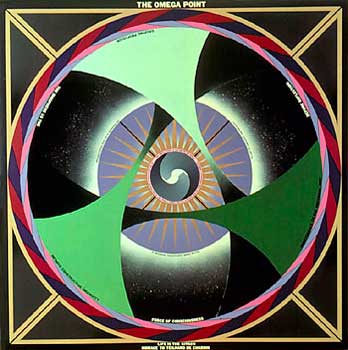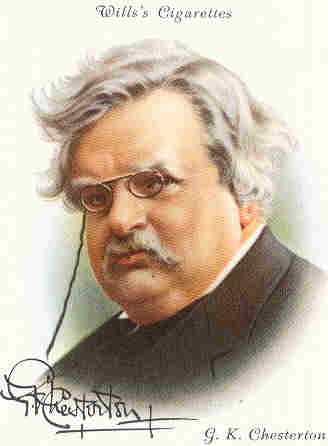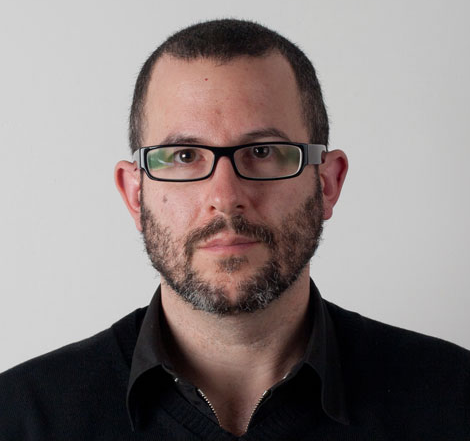
A Teilhard Techgnosis remix
Last December, Pascal Rousseau, a French art historian with a fun philosophical name, asked me to contribute something techngnostic for the issue of Palais de Tokyo’s Palais magazine he was guest-editing. So I remixed a section of Techgnosis that dealt with Teilhard de Chardin and the concept of the noosphere, looked at from the perspective of our growing network society. The issue, no. 5, which fans of Strange Attractor and other cultural forteana will love, is inspired by the work of Loris Gréaud, a young French artist who has currently taken over the Palais with his hyperreal installations.
When the Jesuit paleontologist Pierre Teilhard de Chardin died in New York City on Easter Sunday, 1955, few people noticed. Though the priest was known as a scientist of sorts, the writings that would bring him posthumous fame—incandescent and poetic speculations about cosmic history and the future of humanity—remained largely unpublished. The reason was simple: the essays of his that had seen the light of day were so weird that certain Catholic bureaucrats had begun to murmur about excommunication. Rather then take this drastic step, Teilhard’s superiors simply forbade him from publishing.
They also effectively banished him to China for many years, where he dated fossils, sifted through Gobi desert dust, and helped dig up the Peking man. Teilhard was living in the East when his spiritual meditations on the history of Earth led him to write The Phenomenon of Man, a masterwork of mystical science whose sweeping and giddily optimistic view of humanity’s role in the evolution of cosmic consciousness has come to inform one of the most important questions that now tugs on hearts and minds around the planet: what is the nature of the new global network we now find ourselves enmeshed within? A global brain, a Gaian mind, a final shattering of the vessels?
Christianity has often been accused of institutionalizing a dangerous rupture between humanity and nature. But Teilhard argued the opposite: humanity, including its art, gadgets, and religions, is part and parcel of the planet’s evolutionary thrust. Teilhard rejected the bitterness of Manichean myth, and proclaimed “the spiritual value of matter.” He saw evolution in a generally Darwinian spirit, as the progressive unfolding of biochemical complexity. But for Teilhard, this process also generated ever-greater organizations of consciousness. As the edge of evolution crawled from rocks to plants to the beasts of land and sea, consciousness simultaneously grew into ever more novel and complex architectures of mind, architectures that he believed were intrinsic and internal to material forms. Eventually, this two-fold process resulted in the subjective dimension of the human brain that allows you to understand these words. Consciousness, then, can be imagined as a kind of field cloaking and interpenetrating material form, and self-consciousness a fold in that field that allows the field to see itself.
Because of the intimate connection between consciousness and the evolution of form, Teilhard saw the emergence of the human psyche and its collective webs of culture and civilization as far more than serendipitous froth on the surface of Darwin’s random soup. Over time, these structures of consciousness have come to constitute the leading edge of the evolutionary force of Earth itself, a planet that Teilhard saw, in a prescient intuition of James Lovelock’s Gaia hypothesis, as a “super-organism.” In this, Teilhard echoed the thoughts of the eminent biologist Sir Julian Huxley, son of the great Darwinian cheerleader Sir Thomas Huxley and brother to the novelist and philosopher Aldous. Huxley argued that, “For good or evil, the mechanism of evolution has in the main been transferred onto the social and conscious level…The slow methods of variation and heredity are outstripped by the speedier processes of acquiring and transmitting experience.”
Certainly you don’t have to be a teleologist like Teilhard to recognize the dominant role that human consciousness and culture now play in the earth’s evolutionary process. But what is particularly compelling about Teilhard’s vision is that his ultimately mystical conception of consciousness emerges from a materialist understanding rooted in biological form and, by extention, media technology. From its very beginnings, the Jesuit believed, the human mind was woven into a collective matrix of culture and communication, an etheric web of consciousness that not only linked individual humans, but was destined to cloak the entire biosphere like an onion skin. Teilhard called this cerebral crown of creation the “noosphere,” a collective psychic entity that emerged out of the same symbiotic drive towards interconnection and complexity that initially led freelance chemical elements to band together as molecules and cells. In the noosphere, the binding units are not chemicals but human minds, the accumulated accretions of imagination, language, and thought. The noosphere itself evolves, and as it continues “adding its internal fibers and tightening its network,” it will rope human individuals into increasingly collective forms of consciousness.
Teilhard extended this evolutionary optimism to encompass the pell-mell march of twentieth-century technology. The Jesuit praised all those possessed by the “demon (or angel) of Research,” because they recognized that the world is a “machine for progress—or rather, an organism that is progressing.” Media technologies become vessels of the expanding noosphere, the body and nervous system of a world consciousness striving to be. Electric infotech has been considered a kind of “nervous system” since the days of the telegraph, and, not surprisingly, Teilhard emphasized the role that electronic media played in the development of his technological “brain of brains.” Writing in the early 1950s, he underscored the global reach of radio, cinema, and television, while also drawing attention to “the insidious growth of those astounding electronic computers.”
Anticipating the conceptual fusion (and confusion) of the made and the born that characterizes so many “cyborganic” thinkers today, Teilhard argued that technologies are now directly participating in their own evolution. Machines will continue to beget machines with the persistence of Biblical patriarchs, and their interlinking progeny will eventually intertwine into “a single, vast, organized mechanism.” In a sense, Teilhard recognized the emergent outlines of a worldwide electronic and computational network at a time when few engineers were even thinking about the possibilities of interlinked computers.
Few would deny that contemporary economic and technological forces are combining to increasingly organize social, cultural, economic, and productive fields under the form of the network. Even in the last ten years (since the first version of these thoughts were published), we have seen a significant shift from the paradigm of the networked personal computer—devices that process data within their own guts and only secondarily communicate with other machines—to the paradigm of the computing network itself. One sign of this transformation is the rise of “cloud applications” like Google or Flickr, Internet sites where information storage and data processing occur in the network rather than the “personal” machine. At the same time, the planet itself is being increasingly organized under the form of the network, especially networks of surveillance and other data tracking devices. GPS devices, sensors, and widely flung relay stations for the collection and dissemination of information are spreading through the physical space of the planet, from the frozen tundra to the deep rifts of the sea to that camera just over your shoulder. As Teilhard envisioned, the spread of network consciousness in part takes the form of a field of information which blankets the material planet.
Teilhard believed that the evolutionary process reflected in the noosphere will not quit until this matter achieves an ultimate state of super-organization, although what that means exactly is unclear. In any case, the earth will achieve consciousness, and collective humanity will kick up its heels for the apocalyptic collapse of space and time. With matter and mind narrowing to a single point of what Teilhard presciently dubbed “convergence,” we will find ourselves sliding down a cosmic wormhole that Teilhard called the “Omega point.” At that hot dot of ultimate synthesis, the internal spark of consciousness that evolution has slowly banked into a roaring fire will finally consume the universe itself. Christ will “blaze out like a flash of lightning,” and the immense expanse of cosmic matter will collapse like some mathematician’s hypercube into absolute spirit.
<>
Teilhard’s Omega Point clearly foreshadows contemporary techno-materialist depictions of the “Singularity”—that moment, soon to come according to many, that the interpenetrating powers of computation, artificial intelligence, robotics, biological engineering, and nanotechnology combine to produce an event horizon of novelty beyond which our projections cannot reach and before which our minds will crumble—that is, unless those minds reformat themselves to fit the fast onrushing mutation in the pace of material transformation—in other words, in space and time. Though there are compelling technological and even scientific reasons to imagine a convergence of productive forces beyond our ability to imagine, the Singularity—a fundamental bifurcation in planetary evolution—also possesses clear resemblances to more traditional apocalyptic and theological accounts of the end of history.
What is particularly striking about Teilhard is that he boldly tries to bridge this resonant gap between mystical theology and evolutionary materialism. Teilhard’s Omega Point thus fuses two contradictory vectors of the Western spirit: the world-denying ascent toward transcendence and the absolute domination of material reality through technique. “God awaits us when the evolutionary process is complete: to rise above the World, therefore, does not mean to despise or reject it, but to pass through it and sublime it.”
Teilhard’s appeal to Christians wrestling with the theory of evolution is clear. John Haught, a Roman Catholic theologian who argues in a number of influential books that church teachings are not incompatible with Darwin, holds up Teilhard as a model for understanding how a purposeful God might be working through the apparently wayward, and sometimes obscenely cruel, development of material forms. The key for Haught, as for Teilhard, is consciousness: the world of human experience and its forms of understanding overlaps the objects and processes described by physics and information theory, but is not identified with them. The material world produced by Darwinian forces is thus layered with human meanings and perceptions exactly the way that Teilhard’s physical planet is layered with the noosphere.
Here’s the paradox. By substantializing consciousness, by making it a real thing rather than a deluded afterimage of neurons, these Catholic accounts attempt to elude the reductive order of causation demanded by materialists who claim to speak for nothing but “the real thing.” But they have left themselves open to the charge. For by offering relatively thin accounts of consciousness, many materialists leave the elephant in the room—the elephant that is you, dear reader, you and your conscious experience, however fragile and fluctuating.
So how are you navigating the noosphere these days? Still hanging ten on that surf board? I suspect that most of us—you know, the zombies who experience themselves as individuals despite all the reasons to believe that we are actually zombies—approach the growing ferociousness of the network with a great deal of ambivalence. What Teilhard saw as a communion of consciousness seems intimately tied to the evaporation of privacy and the claustrophobic fragmentation of interiority—an evaporation and fragmentation aided and abetted by the spread of surveillance technologies, feedback controls, communication devices, and sensors of all sorts. Given his theology, Teilhard saw this technological communion in positive terms. But from a more quotidian perspective, such communion may look less like mystical absorption than an identity crisis.
In Techgnosis, I talked about how the new worlds of online networking and interactive hypermedia are unthreading the bindings of the “Gutenberg self” Marshall McLuhan described. This self was associated with the technology of the book: a person who was the author of his thoughts and the reflective subject of an individual narrative life. Today the text of the literate self continues to ravel into an immense hypertext, an electronic garden of forking paths guided and overseen by increasingly intense and complex cybernetic processes of guidance, anticipation, and control. While fascinating new forms of human collaboration have opened up through this mutually colonizing control—a process the cyber-philosopher Pierre Lévy calls “collective intelligence”—it remains to be seen how these collectives themselves compete for power and control, and how gingerly they will treat the “non-collective intelligence” that still characterizes the bubbles of our individual lives, with their functional fictions of autonomy. How will anything that resembles a robust human person survive the “an enforced resonance” that Teilhard foresaw as one consequence of his Omega network? Do we care? If the self is a construction, doesn’t it still rest with us to redefine that self rather than sacrifice it to the networks of influence? Or does that urge just reflect the paranoia at the heart of the separate self?
The apocalyptic Catholic theology that Teilhard transformed into his heretical science fiction has long wrestled with the question of how individual souls might be subsumed into the mystical Body of Christ without losing their unique character. What preserves persons subsumed in a network? Laws, techniques, institutional forms all contribute, but there is also a creative poesis required, an actively imagined narration of the self. Though the specific forms of Teilhard’s theology will, I suspect, prove too arcane and parochial to influence such a poesis, a robust and even spiritual vision of the human person may be necessary to keep the hive at bay. Such a vision need not be rooted in biological fact or religious essentialism, but rather the intensification of consciousness as a creative force—a work of revelation and concealment, of hidden folds and open friendships.




